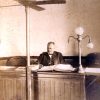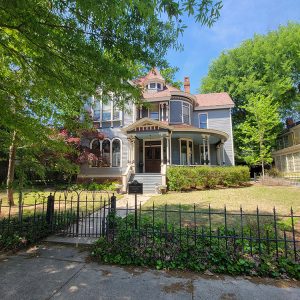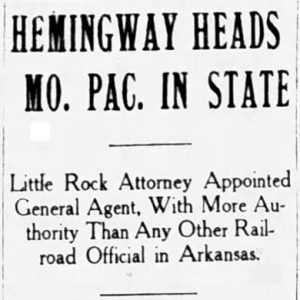calsfoundation@cals.org
Wilson Edwin Hemingway (1854–1922)
Wilson E. Hemingway was an influential figure in Arkansas’s legal community in the later part of the nineteenth and early part of the twentieth century, including brief service on the Arkansas Supreme Court. As an attorney, judge, and corporate leader, he had a sizable impact on Little Rock (Pulaski County) and Arkansas politics, law, and business.
Wilson Edwin Hemingway was born on January 4, 1854, in Carrollton, Mississippi, to William Hemingway and Sarah Wesley Jenkins Hemingway. He grew up in Mississippi and spent two years at the University of Mississippi before spending another two at the University of Georgia. He does not appear to have earned a degree from either school. Hemingway taught school from 1872 to 1873, while also studying law.
He was admitted to the Missouri bar and began to practice in January 1874. From 1875 to 1881 he lived in Potosi, Missouri, serving as prosecuting attorney for Missouri’s Washington County from 1878 to 1881. He moved to Pine Bluff (Jefferson County) in 1882 and was city attorney in Pine Bluff from 1885 until May 1889, when he moved to Little Rock after his election to the Arkansas Supreme Court. He occupied one of the two newly created seats on the bench, a seat whose term was only four years so as to align with the other justices’ terms. Upon completing the first term, he was elected to a full eight-year term in 1893. He chose to resign later that year, however, to return to private practice, joining with Uriah M. Rose and George Rose as a partner in the firm then called Rose, Hemingway and Rose. Before he retired, it would add additional names and the energetic legal minds for which it would become famous, evolving into Rose, Hemingway, Cantrell and Loughborough, one of the forerunners of the current Rose Law Firm. Hemingway remained a partner with the firm for the rest of his life.
He also became heavily involved in a range of railroad utilities. He was most prominently involved with the Little Rock Railway & Electric Company, for which he served as president for about a decade in the early 1900s, and the St. Louis, Iron Mountain and Southern Railway, where he was the vice president and general solicitor from his resignation from the state Supreme Court until 1914. In addition, he served as the general agent for the Missouri Pacific/Iron Mountain.
In July 1872, Hemingway married Mary Helen Girault, a Mississippi native. They had two sons.
A major part of Hemingway’s Arkansas legacy is the Hemingway House in Little Rock. The historic structure sits at 1720 Arch Street in Little Rock, a site purchased in 1890 by Hemingway and his wife. The two-and-a-half-story wood-frame house, designed by renowned Arkansas architect Charles L. Thompson, features the complex massing and exterior that was typical of the Queen Anne period. The home, completed in 1894, includes a projecting bay on the left as well as an array of arched windows on the first floor. In addition, there is a projecting trio of sash windows and a bracket-supported surround that also features a Palladian window in the gable above. The house porch is notable for its turned posts, which have a tapered shape with flared bases and knobs. As one of the oldest examples of Thompson’s work that remains standing, the Hemingway House is a historical monument to the architecture of the late nineteenth century. Following Hemingway’s death, the house was sold, and it was transformed into a boardinghouse that soon fell into disrepair. However, in the 1980s, new owners undertook a major restoration. It was listed on the National Register of Historic Places on December 22, 1982.
Hemingway died of pneumonia on October 5, 1922, in Battle Creek, Michigan, where he had gone to seek treatment for various health problems. He is buried in Mount Holly Cemetery in Little Rock.
For additional information:
“87. Hemingway House.” Quapaw Quarters: History Homes Tour. https://www.littlerock.gov/!userfiles/editor/docs/planning/hdc/QQA%20tour%202014.pdf (accessed October 5, 2018).
Dishongh, Kim. “Creative Couple Brings Modern Touches to Historic Little Rock Home.” AY Magazine, August 2017.
“Hemingway House.” National Register of Historic Places registration form. On file at Arkansas Historic Preservation Program, Little Rock, Arkansas. Online at http://www.arkansaspreservation.com/National-Register-Listings/PDF/PU1465.nr.pdf (accessed October 5, 2018).
Hempstead, Fay. Historical Review of Arkansas: Its Commerce, Industry and Modern Affairs. Vol. 1. Chicago: The Lewis Publishing Company, 1911.
William H. Pruden III
Ravenscroft School










Comments
No comments on this entry yet.